Report on Chromatographic Techniques for Component Identification
VerifiedAdded on 2021/01/01
|6
|1312
|475
Report
AI Summary
This report delves into chromatographic techniques, a crucial method for separating components within mixtures. It explores various techniques like column chromatography, ion exchange, and thin-layer chromatography, evaluating their application and effectiveness. The report analyzes chromatograms, identifying factors that influence separation quality, such as the volatile nature of components and temperature variations. It emphasizes the correct usage of chromatographic methods to produce accurate results and explains how these techniques are employed to separate mixtures, offering insights into the identification of amino acids and other substances. The conclusion summarizes the importance of chromatography in achieving high-quality outcomes in chemical analysis.
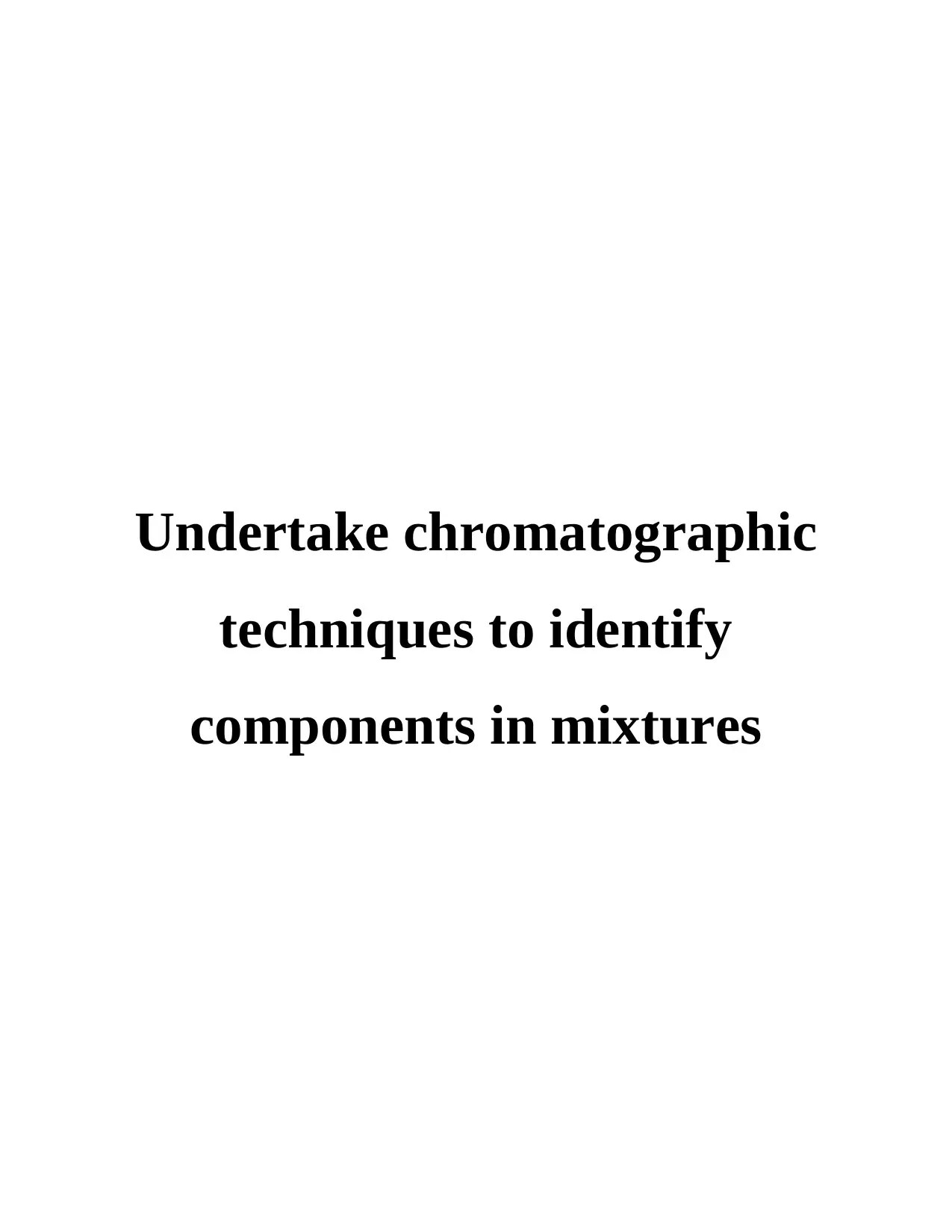
Undertake chromatographic
techniques to identify
components in mixtures
techniques to identify
components in mixtures
Paraphrase This Document
Need a fresh take? Get an instant paraphrase of this document with our AI Paraphraser
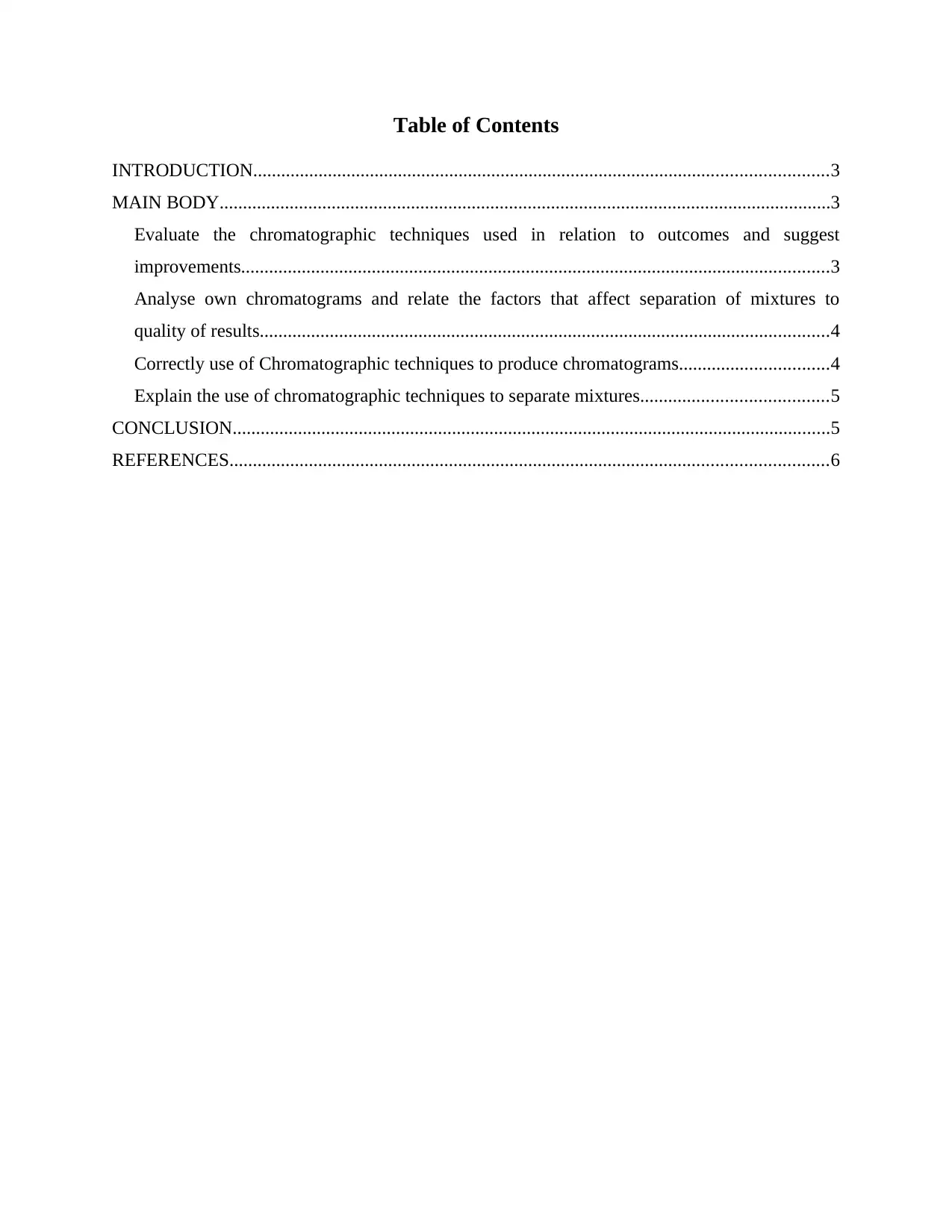
Table of Contents
INTRODUCTION...........................................................................................................................3
MAIN BODY...................................................................................................................................3
Evaluate the chromatographic techniques used in relation to outcomes and suggest
improvements..............................................................................................................................3
Analyse own chromatograms and relate the factors that affect separation of mixtures to
quality of results..........................................................................................................................4
Correctly use of Chromatographic techniques to produce chromatograms................................4
Explain the use of chromatographic techniques to separate mixtures........................................5
CONCLUSION................................................................................................................................5
REFERENCES................................................................................................................................6
INTRODUCTION...........................................................................................................................3
MAIN BODY...................................................................................................................................3
Evaluate the chromatographic techniques used in relation to outcomes and suggest
improvements..............................................................................................................................3
Analyse own chromatograms and relate the factors that affect separation of mixtures to
quality of results..........................................................................................................................4
Correctly use of Chromatographic techniques to produce chromatograms................................4
Explain the use of chromatographic techniques to separate mixtures........................................5
CONCLUSION................................................................................................................................5
REFERENCES................................................................................................................................6
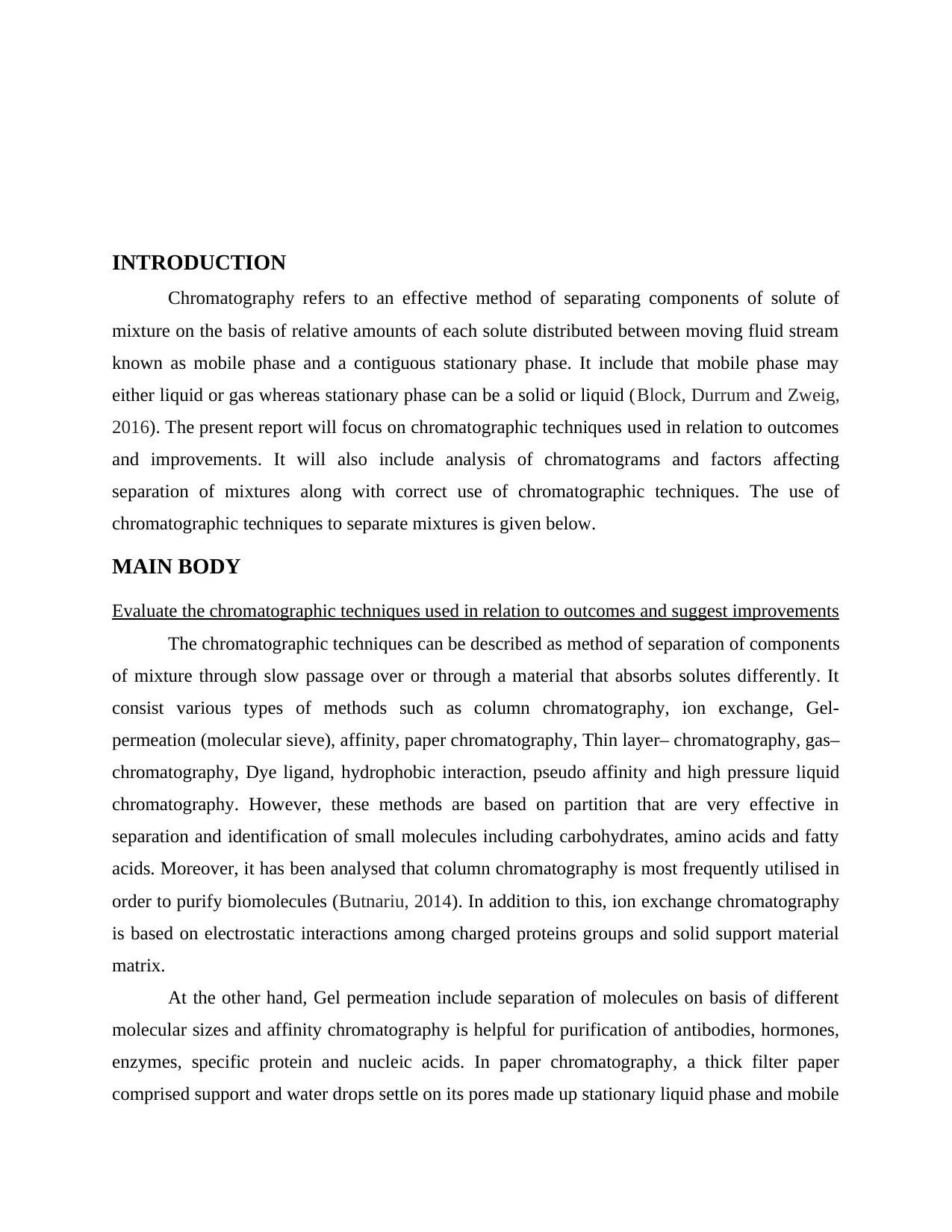
INTRODUCTION
Chromatography refers to an effective method of separating components of solute of
mixture on the basis of relative amounts of each solute distributed between moving fluid stream
known as mobile phase and a contiguous stationary phase. It include that mobile phase may
either liquid or gas whereas stationary phase can be a solid or liquid (Block, Durrum and Zweig,
2016). The present report will focus on chromatographic techniques used in relation to outcomes
and improvements. It will also include analysis of chromatograms and factors affecting
separation of mixtures along with correct use of chromatographic techniques. The use of
chromatographic techniques to separate mixtures is given below.
MAIN BODY
Evaluate the chromatographic techniques used in relation to outcomes and suggest improvements
The chromatographic techniques can be described as method of separation of components
of mixture through slow passage over or through a material that absorbs solutes differently. It
consist various types of methods such as column chromatography, ion exchange, Gel-
permeation (molecular sieve), affinity, paper chromatography, Thin layer– chromatography, gas–
chromatography, Dye ligand, hydrophobic interaction, pseudo affinity and high pressure liquid
chromatography. However, these methods are based on partition that are very effective in
separation and identification of small molecules including carbohydrates, amino acids and fatty
acids. Moreover, it has been analysed that column chromatography is most frequently utilised in
order to purify biomolecules (Butnariu, 2014). In addition to this, ion exchange chromatography
is based on electrostatic interactions among charged proteins groups and solid support material
matrix.
At the other hand, Gel permeation include separation of molecules on basis of different
molecular sizes and affinity chromatography is helpful for purification of antibodies, hormones,
enzymes, specific protein and nucleic acids. In paper chromatography, a thick filter paper
comprised support and water drops settle on its pores made up stationary liquid phase and mobile
Chromatography refers to an effective method of separating components of solute of
mixture on the basis of relative amounts of each solute distributed between moving fluid stream
known as mobile phase and a contiguous stationary phase. It include that mobile phase may
either liquid or gas whereas stationary phase can be a solid or liquid (Block, Durrum and Zweig,
2016). The present report will focus on chromatographic techniques used in relation to outcomes
and improvements. It will also include analysis of chromatograms and factors affecting
separation of mixtures along with correct use of chromatographic techniques. The use of
chromatographic techniques to separate mixtures is given below.
MAIN BODY
Evaluate the chromatographic techniques used in relation to outcomes and suggest improvements
The chromatographic techniques can be described as method of separation of components
of mixture through slow passage over or through a material that absorbs solutes differently. It
consist various types of methods such as column chromatography, ion exchange, Gel-
permeation (molecular sieve), affinity, paper chromatography, Thin layer– chromatography, gas–
chromatography, Dye ligand, hydrophobic interaction, pseudo affinity and high pressure liquid
chromatography. However, these methods are based on partition that are very effective in
separation and identification of small molecules including carbohydrates, amino acids and fatty
acids. Moreover, it has been analysed that column chromatography is most frequently utilised in
order to purify biomolecules (Butnariu, 2014). In addition to this, ion exchange chromatography
is based on electrostatic interactions among charged proteins groups and solid support material
matrix.
At the other hand, Gel permeation include separation of molecules on basis of different
molecular sizes and affinity chromatography is helpful for purification of antibodies, hormones,
enzymes, specific protein and nucleic acids. In paper chromatography, a thick filter paper
comprised support and water drops settle on its pores made up stationary liquid phase and mobile
⊘ This is a preview!⊘
Do you want full access?
Subscribe today to unlock all pages.

Trusted by 1+ million students worldwide
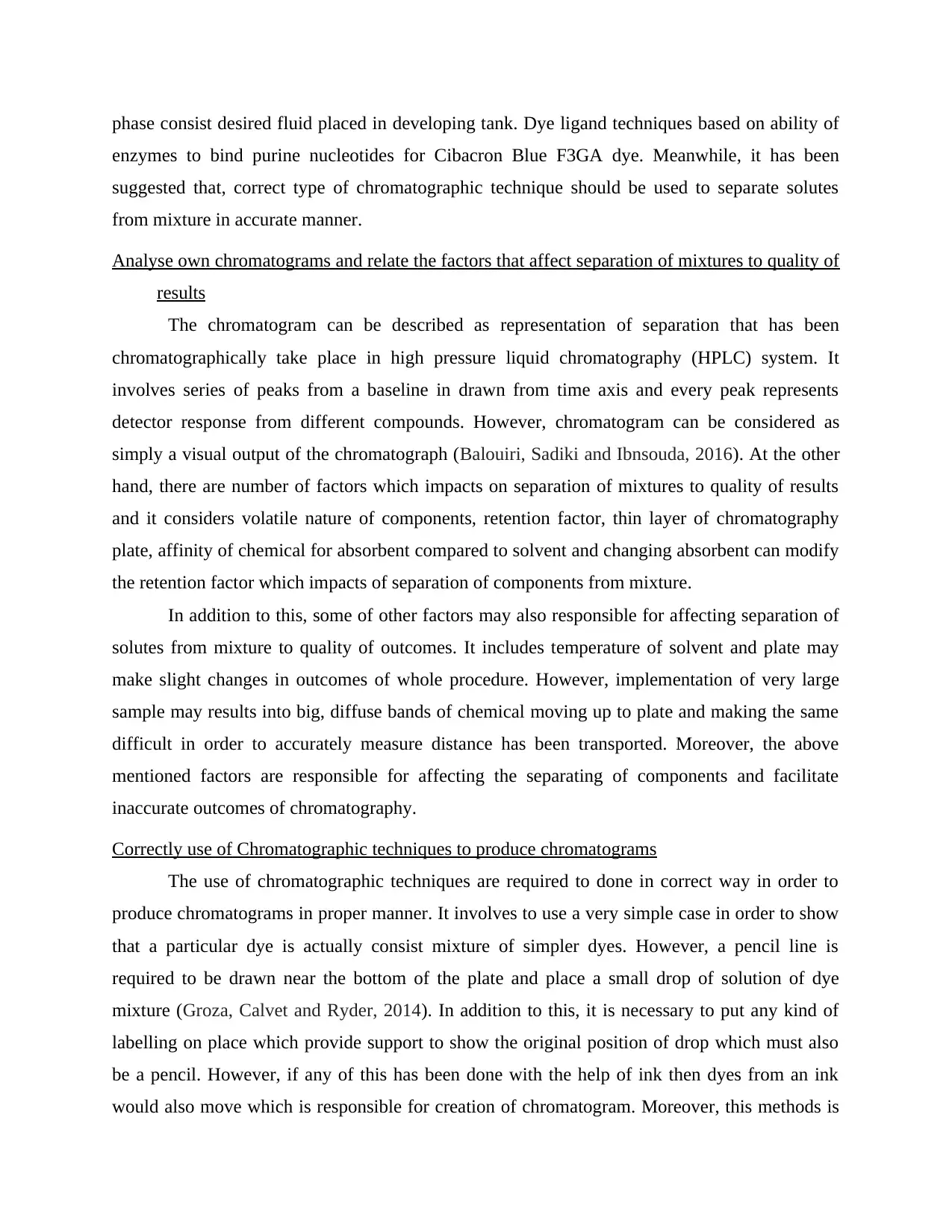
phase consist desired fluid placed in developing tank. Dye ligand techniques based on ability of
enzymes to bind purine nucleotides for Cibacron Blue F3GA dye. Meanwhile, it has been
suggested that, correct type of chromatographic technique should be used to separate solutes
from mixture in accurate manner.
Analyse own chromatograms and relate the factors that affect separation of mixtures to quality of
results
The chromatogram can be described as representation of separation that has been
chromatographically take place in high pressure liquid chromatography (HPLC) system. It
involves series of peaks from a baseline in drawn from time axis and every peak represents
detector response from different compounds. However, chromatogram can be considered as
simply a visual output of the chromatograph (Balouiri, Sadiki and Ibnsouda, 2016). At the other
hand, there are number of factors which impacts on separation of mixtures to quality of results
and it considers volatile nature of components, retention factor, thin layer of chromatography
plate, affinity of chemical for absorbent compared to solvent and changing absorbent can modify
the retention factor which impacts of separation of components from mixture.
In addition to this, some of other factors may also responsible for affecting separation of
solutes from mixture to quality of outcomes. It includes temperature of solvent and plate may
make slight changes in outcomes of whole procedure. However, implementation of very large
sample may results into big, diffuse bands of chemical moving up to plate and making the same
difficult in order to accurately measure distance has been transported. Moreover, the above
mentioned factors are responsible for affecting the separating of components and facilitate
inaccurate outcomes of chromatography.
Correctly use of Chromatographic techniques to produce chromatograms
The use of chromatographic techniques are required to done in correct way in order to
produce chromatograms in proper manner. It involves to use a very simple case in order to show
that a particular dye is actually consist mixture of simpler dyes. However, a pencil line is
required to be drawn near the bottom of the plate and place a small drop of solution of dye
mixture (Groza, Calvet and Ryder, 2014). In addition to this, it is necessary to put any kind of
labelling on place which provide support to show the original position of drop which must also
be a pencil. However, if any of this has been done with the help of ink then dyes from an ink
would also move which is responsible for creation of chromatogram. Moreover, this methods is
enzymes to bind purine nucleotides for Cibacron Blue F3GA dye. Meanwhile, it has been
suggested that, correct type of chromatographic technique should be used to separate solutes
from mixture in accurate manner.
Analyse own chromatograms and relate the factors that affect separation of mixtures to quality of
results
The chromatogram can be described as representation of separation that has been
chromatographically take place in high pressure liquid chromatography (HPLC) system. It
involves series of peaks from a baseline in drawn from time axis and every peak represents
detector response from different compounds. However, chromatogram can be considered as
simply a visual output of the chromatograph (Balouiri, Sadiki and Ibnsouda, 2016). At the other
hand, there are number of factors which impacts on separation of mixtures to quality of results
and it considers volatile nature of components, retention factor, thin layer of chromatography
plate, affinity of chemical for absorbent compared to solvent and changing absorbent can modify
the retention factor which impacts of separation of components from mixture.
In addition to this, some of other factors may also responsible for affecting separation of
solutes from mixture to quality of outcomes. It includes temperature of solvent and plate may
make slight changes in outcomes of whole procedure. However, implementation of very large
sample may results into big, diffuse bands of chemical moving up to plate and making the same
difficult in order to accurately measure distance has been transported. Moreover, the above
mentioned factors are responsible for affecting the separating of components and facilitate
inaccurate outcomes of chromatography.
Correctly use of Chromatographic techniques to produce chromatograms
The use of chromatographic techniques are required to done in correct way in order to
produce chromatograms in proper manner. It involves to use a very simple case in order to show
that a particular dye is actually consist mixture of simpler dyes. However, a pencil line is
required to be drawn near the bottom of the plate and place a small drop of solution of dye
mixture (Groza, Calvet and Ryder, 2014). In addition to this, it is necessary to put any kind of
labelling on place which provide support to show the original position of drop which must also
be a pencil. However, if any of this has been done with the help of ink then dyes from an ink
would also move which is responsible for creation of chromatogram. Moreover, this methods is
Paraphrase This Document
Need a fresh take? Get an instant paraphrase of this document with our AI Paraphraser
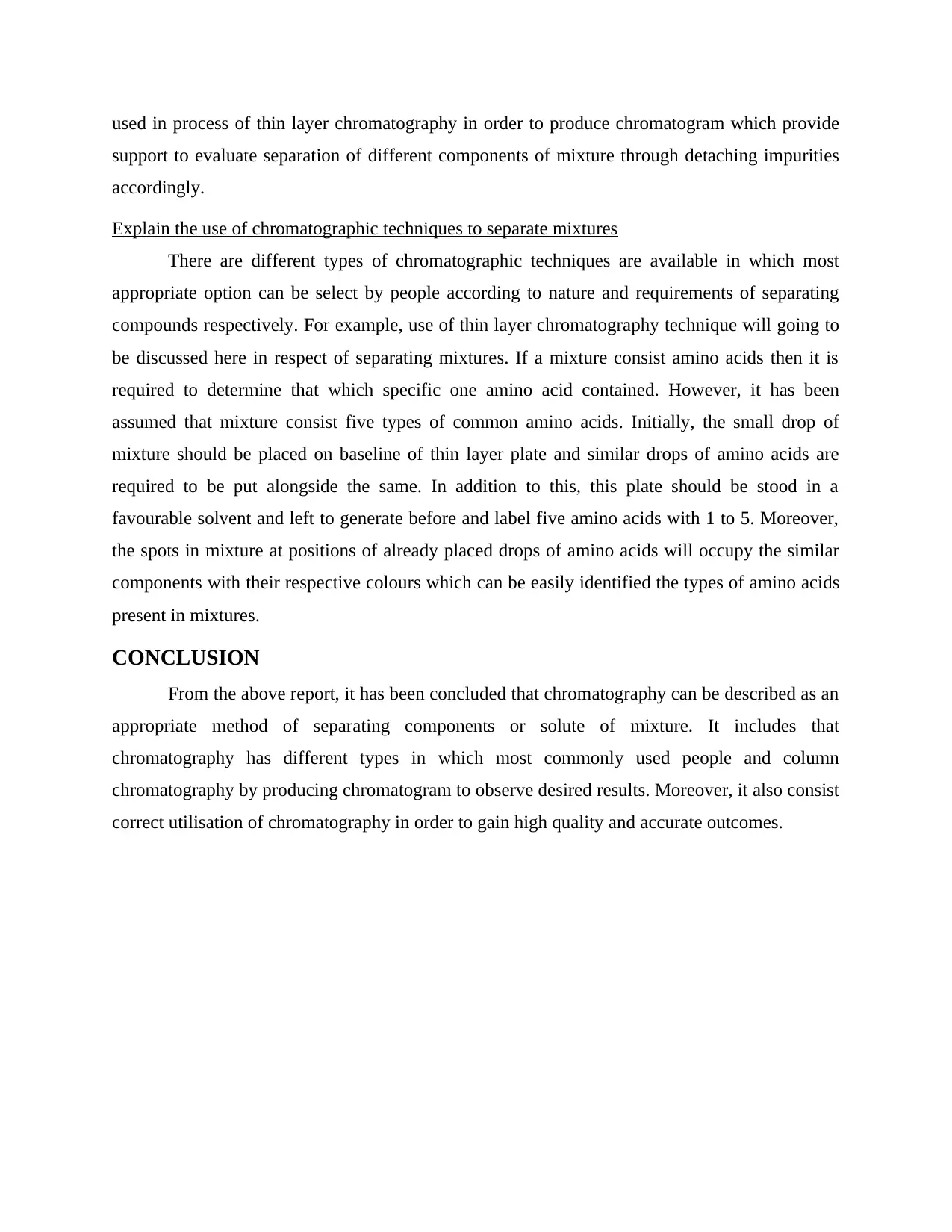
used in process of thin layer chromatography in order to produce chromatogram which provide
support to evaluate separation of different components of mixture through detaching impurities
accordingly.
Explain the use of chromatographic techniques to separate mixtures
There are different types of chromatographic techniques are available in which most
appropriate option can be select by people according to nature and requirements of separating
compounds respectively. For example, use of thin layer chromatography technique will going to
be discussed here in respect of separating mixtures. If a mixture consist amino acids then it is
required to determine that which specific one amino acid contained. However, it has been
assumed that mixture consist five types of common amino acids. Initially, the small drop of
mixture should be placed on baseline of thin layer plate and similar drops of amino acids are
required to be put alongside the same. In addition to this, this plate should be stood in a
favourable solvent and left to generate before and label five amino acids with 1 to 5. Moreover,
the spots in mixture at positions of already placed drops of amino acids will occupy the similar
components with their respective colours which can be easily identified the types of amino acids
present in mixtures.
CONCLUSION
From the above report, it has been concluded that chromatography can be described as an
appropriate method of separating components or solute of mixture. It includes that
chromatography has different types in which most commonly used people and column
chromatography by producing chromatogram to observe desired results. Moreover, it also consist
correct utilisation of chromatography in order to gain high quality and accurate outcomes.
support to evaluate separation of different components of mixture through detaching impurities
accordingly.
Explain the use of chromatographic techniques to separate mixtures
There are different types of chromatographic techniques are available in which most
appropriate option can be select by people according to nature and requirements of separating
compounds respectively. For example, use of thin layer chromatography technique will going to
be discussed here in respect of separating mixtures. If a mixture consist amino acids then it is
required to determine that which specific one amino acid contained. However, it has been
assumed that mixture consist five types of common amino acids. Initially, the small drop of
mixture should be placed on baseline of thin layer plate and similar drops of amino acids are
required to be put alongside the same. In addition to this, this plate should be stood in a
favourable solvent and left to generate before and label five amino acids with 1 to 5. Moreover,
the spots in mixture at positions of already placed drops of amino acids will occupy the similar
components with their respective colours which can be easily identified the types of amino acids
present in mixtures.
CONCLUSION
From the above report, it has been concluded that chromatography can be described as an
appropriate method of separating components or solute of mixture. It includes that
chromatography has different types in which most commonly used people and column
chromatography by producing chromatogram to observe desired results. Moreover, it also consist
correct utilisation of chromatography in order to gain high quality and accurate outcomes.
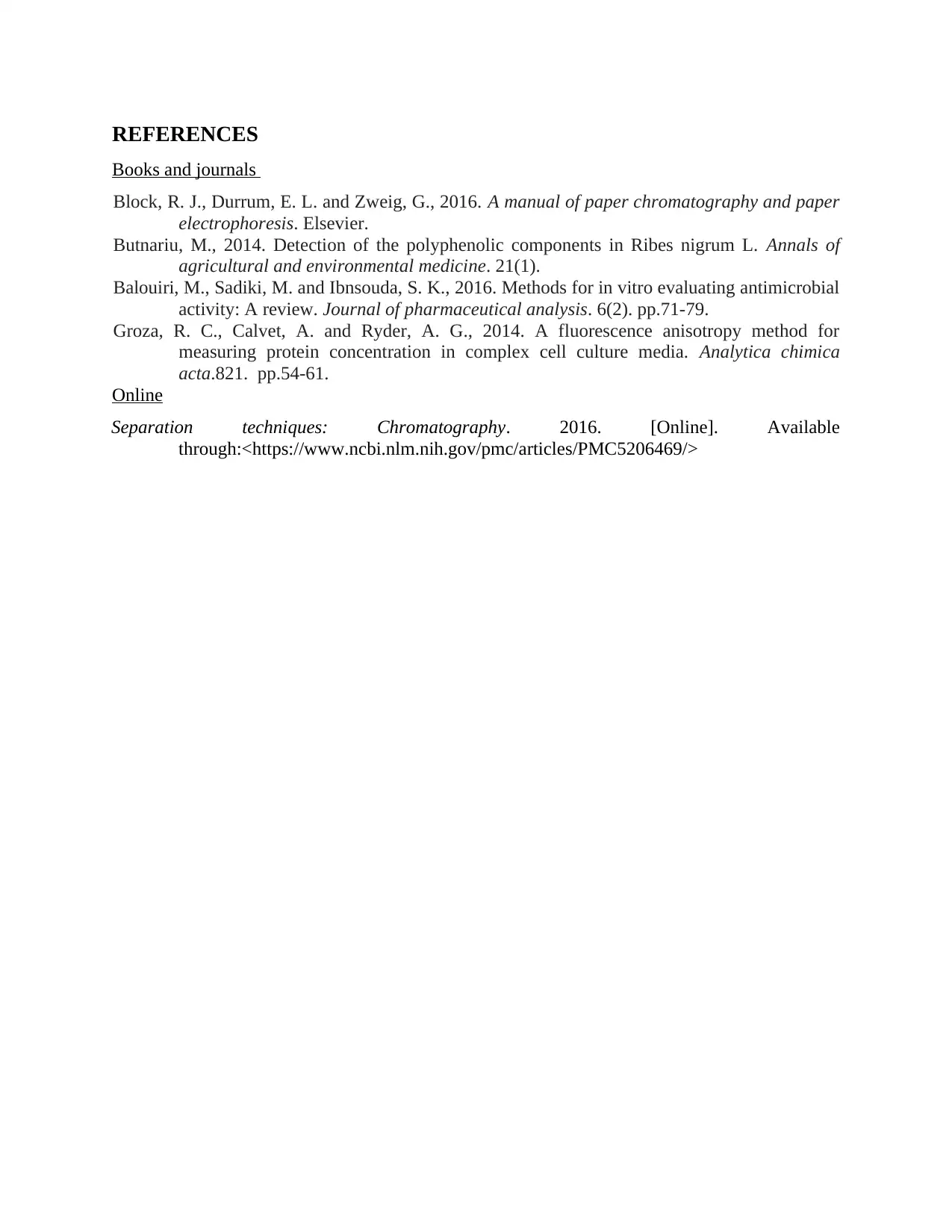
REFERENCES
Books and journals
Block, R. J., Durrum, E. L. and Zweig, G., 2016. A manual of paper chromatography and paper
electrophoresis. Elsevier.
Butnariu, M., 2014. Detection of the polyphenolic components in Ribes nigrum L. Annals of
agricultural and environmental medicine. 21(1).
Balouiri, M., Sadiki, M. and Ibnsouda, S. K., 2016. Methods for in vitro evaluating antimicrobial
activity: A review. Journal of pharmaceutical analysis. 6(2). pp.71-79.
Groza, R. C., Calvet, A. and Ryder, A. G., 2014. A fluorescence anisotropy method for
measuring protein concentration in complex cell culture media. Analytica chimica
acta.821. pp.54-61.
Online
Separation techniques: Chromatography. 2016. [Online]. Available
through:<https://www.ncbi.nlm.nih.gov/pmc/articles/PMC5206469/>
Books and journals
Block, R. J., Durrum, E. L. and Zweig, G., 2016. A manual of paper chromatography and paper
electrophoresis. Elsevier.
Butnariu, M., 2014. Detection of the polyphenolic components in Ribes nigrum L. Annals of
agricultural and environmental medicine. 21(1).
Balouiri, M., Sadiki, M. and Ibnsouda, S. K., 2016. Methods for in vitro evaluating antimicrobial
activity: A review. Journal of pharmaceutical analysis. 6(2). pp.71-79.
Groza, R. C., Calvet, A. and Ryder, A. G., 2014. A fluorescence anisotropy method for
measuring protein concentration in complex cell culture media. Analytica chimica
acta.821. pp.54-61.
Online
Separation techniques: Chromatography. 2016. [Online]. Available
through:<https://www.ncbi.nlm.nih.gov/pmc/articles/PMC5206469/>
⊘ This is a preview!⊘
Do you want full access?
Subscribe today to unlock all pages.

Trusted by 1+ million students worldwide
1 out of 6
Related Documents
Your All-in-One AI-Powered Toolkit for Academic Success.
+13062052269
info@desklib.com
Available 24*7 on WhatsApp / Email
![[object Object]](/_next/static/media/star-bottom.7253800d.svg)
Unlock your academic potential
Copyright © 2020–2025 A2Z Services. All Rights Reserved. Developed and managed by ZUCOL.





